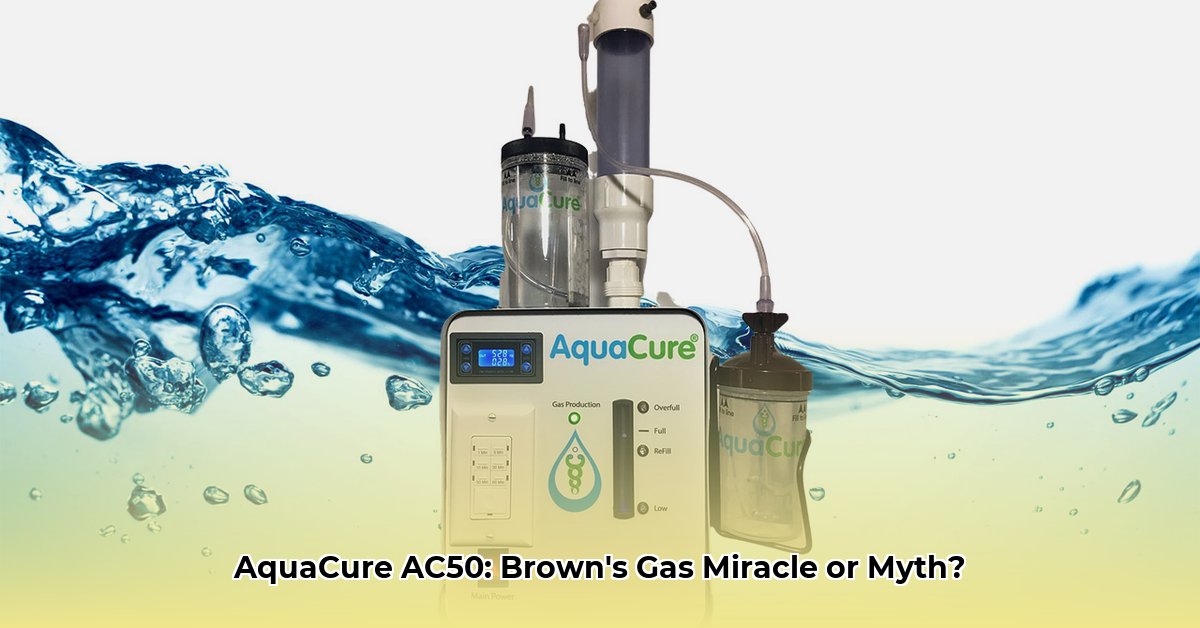
The AquaCure AC50, a device generating Brown's gas (oxyhydrogen), promises various health benefits. However, a balanced assessment requires examining both its technical merits and the significant lack of robust clinical evidence supporting these claims. This review delves into the device's functionality, the science behind Brown's gas, and the crucial need for further research before accepting its purported health benefits.
Understanding Brown's Gas: Electrolysis and Unanswered Questions
Brown's gas is a mixture of hydrogen and oxygen, produced by the electrolysis of water. The AquaCure AC50 uses this process, splitting water (H₂O) into its constituent elements – hydrogen (H₂) and oxygen (O₂) – using an electrical current. While the process itself is well-understood, the health claims surrounding Brown's gas remain largely unproven. A poorly understood energy-rich component, often referred to as "ExW," further complicates the picture, making it challenging to fully assess its effects on human health.
The AquaCure AC50: Technical Specifications and Safety Features
The AC50 boasts a production capacity of up to 50 liters of Brown's gas per hour, operating at a relatively low power consumption of 250 watts. Eagle Research, the manufacturer, has a history in similar equipment, suggesting a degree of manufacturing competence. The device incorporates safety features like automatic shutoff mechanisms if water levels are low and alarms to alert users to potential problems. These features point to a focus on user safety, a positive aspect of the device. However, these safety features do not address the core issue of lacking evidence for the claimed health benefits.
Health Claims: Anecdotal Evidence vs. Scientific Proof
Many users report positive health outcomes, sharing testimonials detailing improvements in their well-being. These personal accounts are valuable in understanding user experience, but they fall far short of providing scientific proof. The absence of large-scale, well-designed clinical trials to validate these claims represents a significant limitation. The manufacturer acknowledges the lack of FDA approval and refrains from making explicit medical claims, a responsible approach given the current state of evidence. This lack of clinical evidence necessitates a cautious approach to the device's claimed therapeutic effects.
Regulatory Landscape and FDA Approval
The AquaCure AC50 lacks approval from the Food and Drug Administration (FDA) and similar regulatory bodies internationally. This absence signals that the device hasn't undergone the rigorous testing required for marketing as a medical device. While the lack of FDA approval doesn't inherently indicate danger, it underscores the need for critical evaluation of the health claims. This lack of regulatory scrutiny increases the importance of independent verification and robust clinical trials.
A Balanced Perspective: The Verdict
The AquaCure AC50 presents a mixed picture. Its technical aspects, including its manufacturing and safety features, appear reasonable. However, the core issue remains: the significant lack of scientific evidence supporting its purported health benefits. Consumers should exercise extreme caution and skepticism concerning the health claims, prioritizing consultation with healthcare providers before using the device for therapeutic purposes.
Moving Forward: Recommendations for Research and Responsible Use
To establish the validity of the AquaCure AC50’s health claims, several parties must take action:
- Eagle Research: Must conduct rigorous, independent clinical trials to rigorously test the device's efficacy and safety. Transparency in reporting results, both positive and negative, is crucial. The company should also actively seek necessary regulatory approvals.
- Healthcare Professionals: Should inform patients about the lack of scientific support for the health claims associated with the AquaCure AC50. They should counsel patients against using the device for medical treatment without complete understanding of risks and benefits.
- Regulatory Agencies: Should increase scrutiny of products making unsubstantiated health claims and develop clearer guidelines evaluating similar devices. This will allow for a standardized assessment approach and offer greater protection for consumers.
Risk Assessment: Potential Hazards and Mitigation Strategies
The following table summarizes potential risks associated with the AquaCure AC50 and strategies for minimizing them:
| Aspect | Likelihood | Severity | Mitigation Strategies |
|---|---|---|---|
| Machine Malfunction | Low | Medium | Regular maintenance; use of high-quality water; adherence to instructions |
| Safety System Failure | Low | High | Regular safety checks; strict adherence to operating procedures |
| Unproven Health Claims | High | High | Consult healthcare provider; avoid using for unproven medical purposes |
| Legal Issues (Manufacturer) | Medium | High | Gaining necessary regulatory approvals; transparent marketing |
This review aims to provide an objective and balanced evaluation. While the AquaCure AC50 possesses certain technical merits, the absence of robust clinical evidence necessitates caution regarding its purported health benefits. Further research is essential before any definitive conclusions can be reached. The onus is on the manufacturer and regulatory bodies to address these critical knowledge gaps.